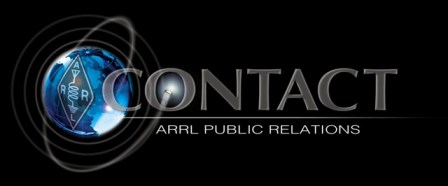CONTACT - July 2015
Vol 13 # 7
In this issue:
2015 ARRL Field Day is history. Despite the weather and bands not being very cooperative for much of the country, media coverage was quite good. Over 180 stories on Field Day from all across the country made it to the ARRL Media Hits page, covering ham radio from perspectives ranging from emergency preparedness to offering a way into electronics and science. California, Florida, Indiana, North Carolina, Ohio, Oklahoma, Texas, Washington, and Wisconsin were particularly well represented. Nice job, all!
Roanoke Vice Director Bill Morine, N2COP, reminds us to keep tabs on radio and TV news stories about ham radio: “[P]lease let the PR reflector know about any broadcast radio interviews or stories, as these are often not captured by search engines such as Google the way that print/newspaper and broadcast TV stories are captured.” Good advice.
Field Day took to social media in a big way this year. ARRL created a Field Day “Event” on their Facebook page; over 1,400 people said they would “attend” the event, and the page served as an online area for people to ask questions, share tips, and enjoy the lighter side of Field Day, all in real time. Photos, video, and write-ups of clubs’ Field Days were all over the Field Day event page. Look for an ARRL Field Day event page on Facebook every year.
On a side note, I think we could begin doing a separate social media story line about Field Day cakes. I didn't realize how many groups make a special radio-themed cake for their Field Day group.
ARRL’s Hurricane Season webinar will take place on Monday, July 20, at 8PM Eastern time. It will run approximately 90 minutes.
The program will include presentations by representatives of the National Hurricane Center and WX4NHC, the VoIP Hurricane Net, the Hurricane Watch Network, the Canadian Hurricane Centre, and ARRL. Webinar registration is open to all, but should be of particular interest to radio amateurs in hurricane-prone areas. The webinar will conclude with a Q&A session.
Registration is free. The last ARRL Hurricane webinar was held in July 2013. Over 400 people attended.
ARRL PR Committee member Ward Silver, NØAX, was presented an opportunity to write an introductory article on ham radio for Make: magazine. The Makers are a group of “our” people, full of electronics experimenters and tinkerers just like us. Extending an invitation to them could mean a lot for the future of ham radio. Consider giving a talk to your local Maker group, or better yet, create a “Maker-Ham Radio Learning Day,” with presentations and information from both camps. Find ways to get ham radio clubs and Makerspaces to collaborate and create.
Special thanks to Jeff Schmidt, N5MNW, and ARRL South Texas Section Manager Lee Cooper, W5LHC, for their assistance in making this article happen.
We always enjoy having new PIOs join us. Please makes these new PIOs and PICs feel welcome!
Public Information Officers (PIOs):
Alabama: Thomas W. Knotts, WA4UBW
Ohio: John Myers, KD8MQ
Western Pennsylvania: Bryan J. Simanic, WA3UFN
Public Information Coordinators (PICs):
Rhode Island: Normand Deragon, W1CVC
As we rest after another Field Day effort, it’s clear we did a good job collectively of getting media coverage. But how are changes in technology affecting the message we deliver?
Gordon Moore, co-founder of Intel, posited in 1965 that technology — more specifically, the number of components in an integrated circuit — doubles roughly every 18 months. This is now known as Moore’s Law, and has proved so accurate that it is used as a standard measurement in many electronics companies to set targets for research and development.
The average citizen has more communications capabilities in his or her back pocket than ever before. No, those systems are not 100% reliable, but well-funded research and development is making them more and more robust. This cannot help but have an effect on communications capabilities as time goes on. This trend is highlighted in this article about how Mississippi’s emergency communications plan has evolved since Hurricane Katrina, and this article on how the National Weather Service increasingly relies on social media for ground truth reports during tornadoes; Amateur Radio is mentioned almost as an afterthought.
There will always be a place for Amateur Radio during emergencies. But if we accept Moore’s Law, what will that role look like in 30 years?
Diversifying our PR outreach beyond “When All Else Fails” is necessary for ham radio PR to be successful in the long haul. We must engage and recruit more people to ensure Amateur Radio will continue to thrive. Amateur Radio must be promoted as one of the first places to go for electronics knowledge, education, and experimentation, not merely the last line of defense.
Can you think of ways you can promote Amateur Radio to your community that are based on strategies other than disaster communications?
Thanks for all you do,
Sean Kutzko, KX9X
ARRL Media and Public Relations Manager
About ARRL >> Media and Public Relations >> Contact Issues >> Contact 2015 >> July 2015





